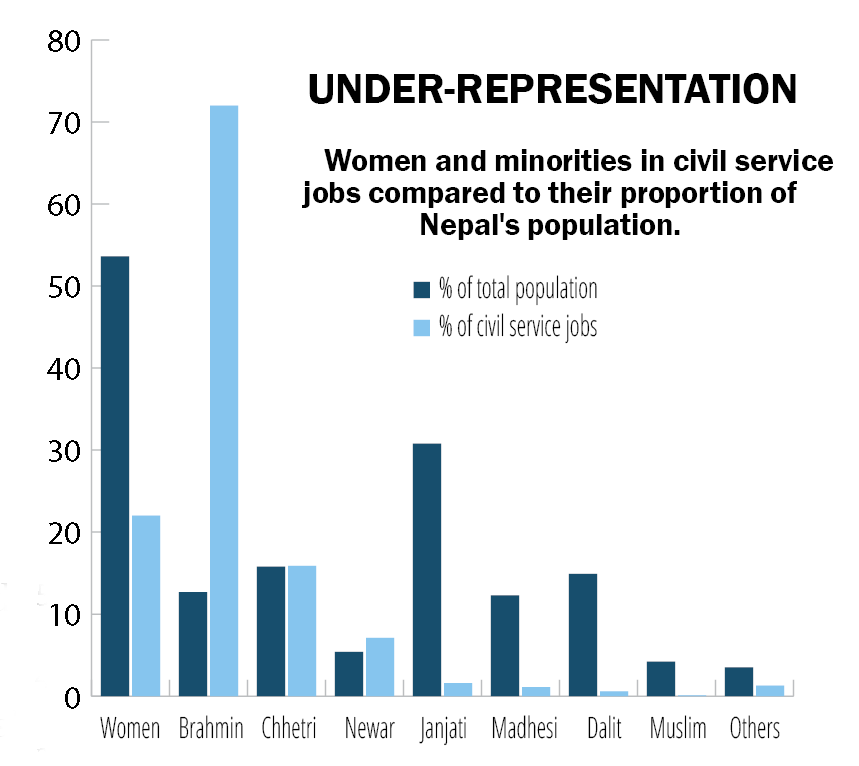Whose country is it anyway?
The most powerful individuals in Nepal are all ‘high’ caste menPresident Ram Chandra Paudel. Prime Minister Pushpa Kamal Dahal. Speaker of the House Dev Raj Ghimire. Army Chief Prabhu Ram Sharma and Police Chief Dhiraj Pratap Singh. Acting Chief Justice Hari Krishna Karki. Nepal Rastra Bank Governor Maha Prasad Adhikari.
The most powerful people in Nepal today are all men, and all from dominant caste groups.
Top leaders of all major political parties are also all men: Dahal, K P Oli, Sher Bahadur Deuba, Baburam Bhattarai, Madhav Nepal, Rabi Lamichhane, Rajendra Lingden, Mahanta Thakur, Upendra Yadav.
The 2015 Constitution has strict quota provisions for the representation of women, Indigenous people and Dalits in Nepal’s legislature, government and bureaucracy.
Prithvi Nayaran Shah called Nepal a ‘garden of diverse ethnicities and castes’ but this is reflected nowhere in the corridors of power today.
To be sure, affirmative action and Constitutional provisions for inclusion mean better representation than before of marginalised groups in all sectors.
The 2015 Constitution mandated that 33% of MPs had to be women. In the 2017 elections, women were elected to every local unit as either a mayor or deputy mayor, or both. The Constitution also has a quota for Dalit representation in every ward.
True, many women and minorities tended to be nominal nominations to ceremonial posts just to fulfil quota requirements.
But electoral alliances between political parties with diametrically opposing views in the 2022 elections to all three levels of government meant women and minorities did not even get those token positions.

There is also pushback from dominant caste groups against reservation, arguing that it goes against meritocracy and that more qualified individuals miss out on opportunities to rise up the ranks.
But for a country where the scale of social justice is so skewed, historically-excluded groups need to be given a chance to catch up through proportional representation. A quota system gives a much-needed push for the underserved to at least be more visible, even if they do not immediately become decision-makers.
Read Also: Political patriarchy, Editorial
Yet, reservation laws can be abused. Former president Bidya Devi Bhandari was openly doing the bidding of UML Chair Oli when he was prime minister. There are many examples of women deputy mayors who are not equipped to fully perform the required roles.
Which is why it is crucial that women, Indigenous people, Dalits and other minorities are empowered to function. This can be made to happen through education, training, financial independence and exposure.
The very first step will be to recognise just how lopsided the whole process is. As the largest party in Parliament, the Nepali Congress (NC) and the third largest Maoist Centre gave tickets for just one woman candidate each in direct elections last year. In Karnali and Sudurpaschim Provincial Assemblies there is not a single woman elected through direct ballot.
Even though women have 20% of jobs in the bureaucracy, they have only 4% of the topmost positions. Brahmins make up only 12.7% of Nepal’s population, but hold 70% of higher jobs in civil service.
Janjatis are 32% of the population but have less than 2% of senior positions. Dalits make up 15%, but are even less represented, with only 0.7% of special and gazetted jobs.
To solve any problem, we have to first recognise there is a problem. In Nepal, under-representation of the historically-excluded is a problem.
Given platforms, women have generally proven to be better at governance. Jumla and Hupsekot of Nawalparasi were two municipalities in which women were voted both chair and deputy in the 2017 local election. They helped improve education, agriculture, conservation, and had effective Covid-19 response in their localities.
Nepal’s female ambassadors have been exemplary in dealing with migrant issues, tourism promotion and economic diplomacy.
Read Also: Post-presidential politics, Shristi Karki
Kulman Ghising, Sanduk Ruit and Mahabir Pun are lauded by Nepalis as national heroes. All three belong to Indigenous groups — proof that inclusion is not just morally right, but that there is strength in diversity.
Eventually, we have to move beyond quota-enforced inclusion to one that includes and engages all groups by default. Till then, because some are more equal than others, the excluded need that extra weightage.
The election for Vice President is slated for Friday 17 March. Two of the three candidates are women: Asta Laxmi Shakya of the UML and Mamta Jha of CK Raut's Janmat Party. But Ram Sahay Yadav of Janata Samajbadi Party (JSP) is the heavy favourite to win, even though the Constitution recommends that the vice president should be female if the president is male. Need we say more?
Sonia Awale




